In the realm of modern gardening and agriculture, grow bags have emerged as a cornerstone for both enthusiasts and professionals. These versatile containers offer a myriad of benefits, from enhancing root health through improved air circulation to providing an adaptable solution for space-limited environments. As environmental considerations become increasingly paramount, the move towards using sustainable and efficient growing mediums is undeniable. Grow bags, with their array of materials, sizes, and designs, cater to this shift, enabling optimized plant growth while aligning with eco-friendly practices. Their role in contemporary horticulture underscores a blend of innovation and practicality, addressing the nuanced needs of today’s gardens and agricultural ventures.
Table of Contents
1. Grow bag essentials: types and applications
2. 2024 market insights for grow bags
3. Key selection criteria for premium grow bags
4. Spotlight on 2024’s leading grow bag models
5. Conclusion
Grow bag essentials: types and applications
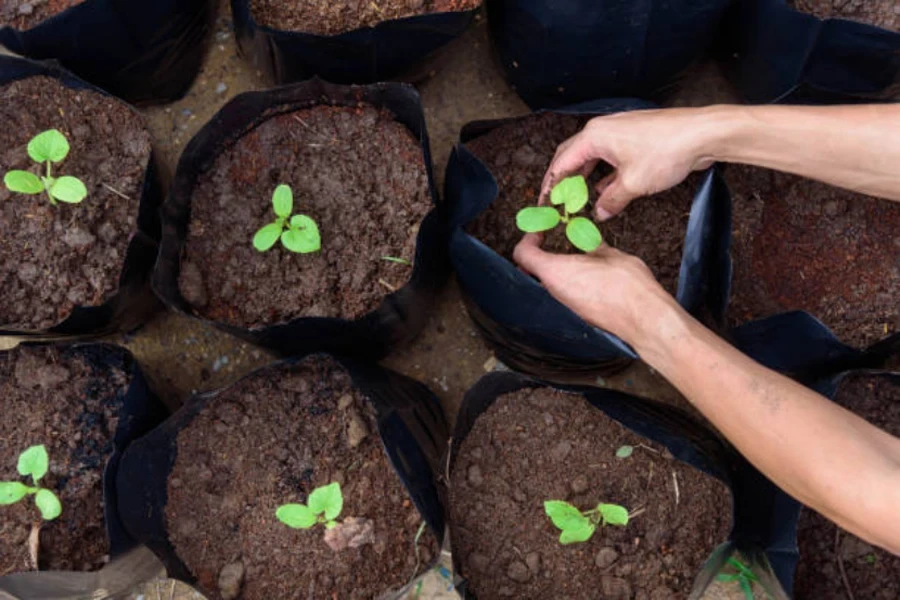
In the realm of modern gardening and agricultural practices, the adoption of grow bags has marked a significant evolution. Not just a trend, these flexible containers offer a versatile solution to several cultivation challenges faced by professionals today.
Fabric quality and breathability
The evolution of grow bags has introduced a range of fabric qualities and breathability options, each designed to optimize plant health and yield in unique ways. Understanding the types of grow bags based on their fabric characteristics is essential for making informed choices that directly influence cultivation success.
Non-Woven Fabric Grow Bags: Non-woven fabric grow bags are celebrated for their superior breathability and moisture management capabilities. This type of fabric promotes air circulation around the roots, encouraging a phenomenon known as air pruning. When roots reach the bag’s edge, air exposure halts their outward growth and stimulates the growth of new root branches within the bag. This results in a more fibrous root system capable of absorbing nutrients and water more efficiently, thereby enhancing plant growth and yield.
The non-woven fabric’s porous nature also ensures excellent drainage, preventing waterlogging and the associated risk of root diseases. Plants grown in such conditions exhibit healthier growth patterns and increased resilience against environmental stressors. The VIVOSUN Square Grow Bags exemplify this category, offering a balance of durability and root-friendly growing conditions.
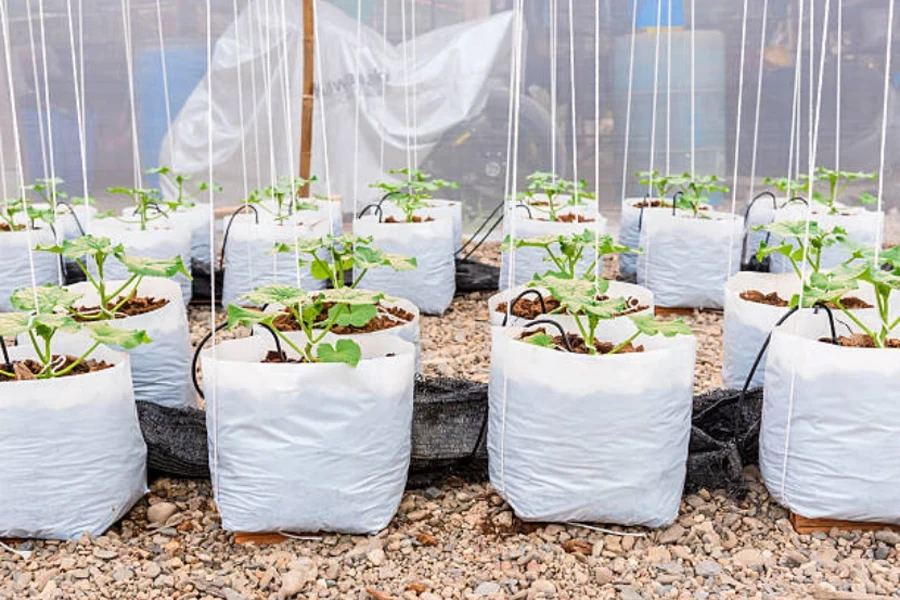
Breathable Plastic Grow Bags: An alternative to traditional non-woven fabric bags is breathable plastic grow bags. These are usually made from a softer, more pliable plastic material with perforations or woven patterns that allow for some degree of air and water exchange. While not as breathable as their fabric counterparts, these bags offer a cost-effective solution with somewhat improved aeration over standard plastic pots. They can be a suitable option for growers prioritizing ease of cleaning and reuse.
Recycled Material Grow Bags: Grow bags made from recycled materials, such as the innovative Root Pouch Grow Bag, are gaining traction for their environmental benefits and breathability. These bags, often made from recycled bottles or textiles, provide a sustainable option without compromising on plant health. The recycled materials ensure good air flow and water drainage, supporting robust plant development. Additionally, they underscore the gardening industry’s shift towards more eco-conscious practices.
Impact of Material Choice on Plant Health and Yield: The choice of grow bag material significantly impacts plant health and yield. Breathable fabrics facilitate air pruning and prevent overheating of the root zone, leading to healthier, more vigorous plants. This can directly translate into higher yields, as a well-developed root system can absorb nutrients more efficiently. Moreover, the improved drainage and aeration offered by these materials reduce the likelihood of root diseases, further enhancing plant productivity.
Size and shape variations
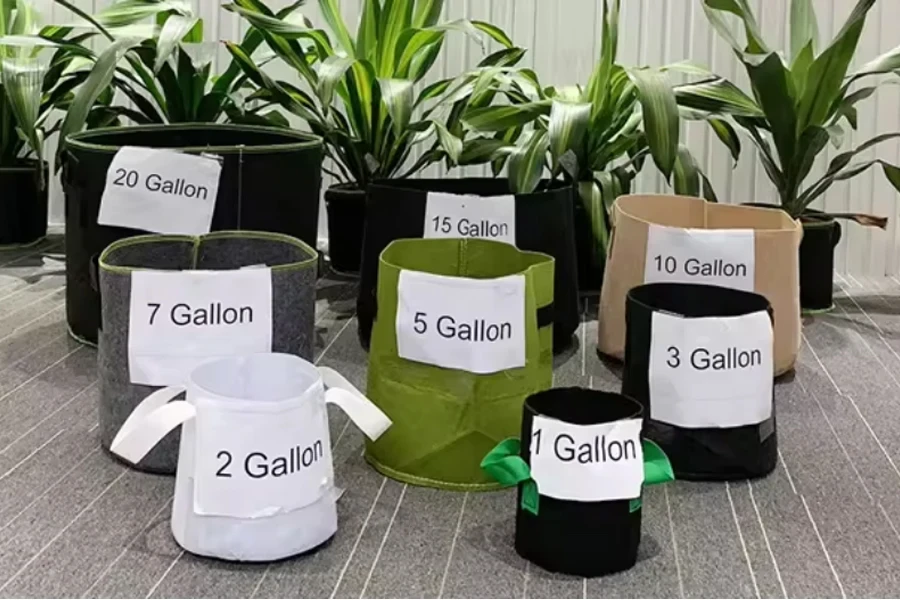
The versatility of grow bags extends beyond fabric composition to include a wide array of sizes and shapes, each designed to cater to the specific needs of different plant types and spatial arrangements. This diversity ensures that there is a grow bag solution for virtually every gardening scenario, from compact indoor setups to expansive outdoor plots.
Small Grow Bags: Small grow bags, typically ranging from 1 to 3 gallons in size, are ideal for cultivating herbs, small flowers, and leafy greens. These bags are perfect for gardeners with limited space, such as balconies or small patios. The compact size of these bags makes them easy to move and arrange, allowing for flexibility in garden design and the ability to maximize sunlight exposure by adjusting the placement of the bags throughout the growing season.
Medium Grow Bags: Medium-sized grow bags, generally between 5 to 10 gallons, are suited for a broader range of plants, including larger vegetables like tomatoes, peppers, and cucumbers, as well as small shrubs. These bags offer sufficient space for the root systems of these plants to develop without becoming constrained, which is critical for healthy growth and optimal yield. Medium grow bags can be utilized in both indoor and outdoor settings, providing a balance between manageability and capacity.
Large Grow Bags: For gardeners looking to cultivate root vegetables, such as carrots, potatoes, and beets, or for those interested in growing larger plants or multiple plants together, large grow bags are the way to go. These bags can range from 15 gallons up to 100 gallons or more, offering ample room for extensive root systems and ensuring that plants have enough space to reach their full potential. Large grow bags are particularly advantageous for creating movable garden plots on otherwise unusable surfaces, like concrete patios or rooftops.

Specialized Shapes: In addition to size variations, grow bags are available in specialized shapes to accommodate unique growing requirements. For example, vertical grow bags with multiple pockets are designed for growing strawberries or herbs in small spaces, utilizing vertical space efficiently. Similarly, rectangular or square grow bags offer an alternative to traditional round shapes, providing a better fit for certain garden layouts or for use in raised beds.
Analyzing Dimensions for Plant Types and Spaces: The selection of a grow bag’s size and shape should be informed by the specific requirements of the plants being grown and the characteristics of the available space. Smaller plants with shallow root systems can thrive in smaller bags, while larger or root vegetables require more extensive space to flourish. Additionally, the grow bag’s dimensions should be compatible with the spatial constraints and aesthetic considerations of the gardening area.
Understanding the relationship between a plant’s growth habits and the dimensions of a grow bag can lead to more successful gardening outcomes. Properly sized grow bags ensure that plants have enough room to grow without being restricted, which can lead to stunted growth or reduced yields. Conversely, excessively large bags for a given plant type may lead to inefficient use of space and resources.
2024 market insights for grow bags
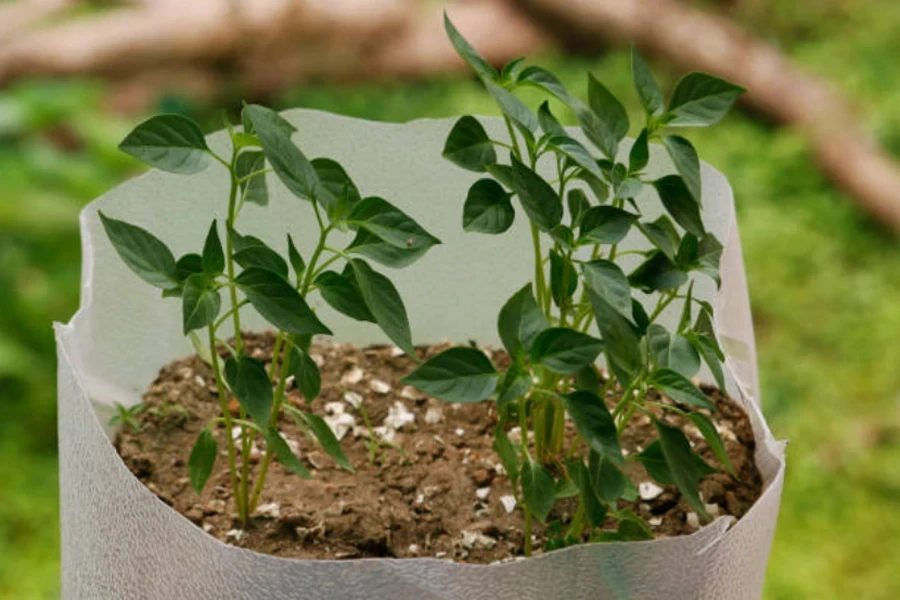
The grow bag sector is experiencing a dynamic shift, reflective of broader agricultural and consumer trends. As the industry progresses into 2024, several key factors are shaping its trajectory, from consumer preferences to sustainability practices.
Growth projections and consumer preferences
The demand for grow bags has seen a steady increase, a trend that is projected to continue as more individuals and businesses turn to urban gardening and sustainable agriculture practices. Experts currently value the agricultural grow bags market at US$ 219 million, and they project it to reach US$ 314.9 million by 2028. This growth is expected to occur at a compound annual growth rate (CAGR) of 6.2% from 2022 to 2028. The market’s expansion reflects a broader trend towards sustainable agricultural practices and the increasing adoption of innovative cultivation techniques to enhance crop productivity amidst evolving environmental challenges.
The appeal of grow bags is largely attributed to their versatility, cost-effectiveness, and alignment with eco-friendly gardening. Consumers are increasingly looking for gardening solutions that are portable, reusable, and less dependent on traditional soil-based cultivation methods. This shift is driven by urbanization trends, space limitations, and a growing awareness of the environmental impact of gardening and farming practices.
Environmental considerations are at the forefront of consumer preferences, with a noticeable preference for products that minimize plastic use and incorporate recycled materials. The market has responded with innovations in grow bag materials, including the use of biodegradable fabrics and recycled plastics, which resonate well with eco-conscious consumers.
Innovations and sustainable practices

Technological advancements and sustainable practices are profoundly influencing the grow bag market. Manufacturers are introducing smart grow bags equipped with sensors that monitor soil moisture levels, nutrient content, and temperature, offering gardeners real-time data to optimize plant care. These innovations not only enhance the gardening experience but also contribute to water conservation and efficient nutrient use, aligning with broader environmental sustainability goals.
The industry’s pivot towards sustainability is evident in the increased availability of grow bags made from renewable resources. Companies are exploring alternative materials such as hemp, jute, and other natural fibers that offer the same benefits as traditional fabric grow bags but with a reduced environmental footprint. These developments reflect a commitment to reducing plastic waste and promoting sustainable agriculture practices.
As we move further into 2024, the grow bag market is set to expand, driven by the dual forces of consumer demand for sustainable, efficient gardening solutions and industry innovations aimed at enhancing plant growth and environmental sustainability. The convergence of these trends points to a vibrant future for the grow bag sector, one that holds promise for both urban and rural gardening enthusiasts alike.
Key selection criteria for premium grow bags
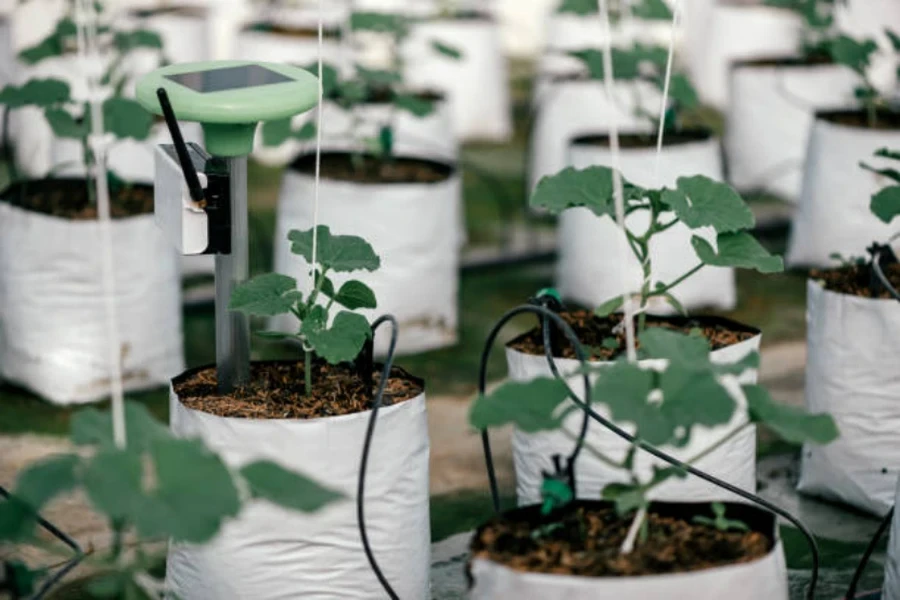
Selecting the right grow bag involves a nuanced understanding of material quality, design features, and the specific needs of the plant types they are intended to support. These criteria ensure that the chosen grow bags not only enhance the health and yield of plants but also contribute positively to environmental sustainability.
Material durability and environmental impact
When selecting premium grow bags, two pivotal factors stand at the forefront: material durability and the environmental impact of those materials. The longevity of grow bags not only influences the cost-effectiveness of agricultural operations but also affects their sustainability footprint.
Longevity and Material Choice: Material durability in grow bags is paramount for ensuring that they can withstand multiple growing seasons without degrading in performance. For instance, grow bags made from high-density, non-woven fabrics can resist tearing and puncturing, extending their useful life and reducing the need for frequent replacements. Materials like polypropylene, which is commonly used in commercial-grade grow bags, offer a robust framework for root development while maintaining structural integrity under varied environmental conditions.
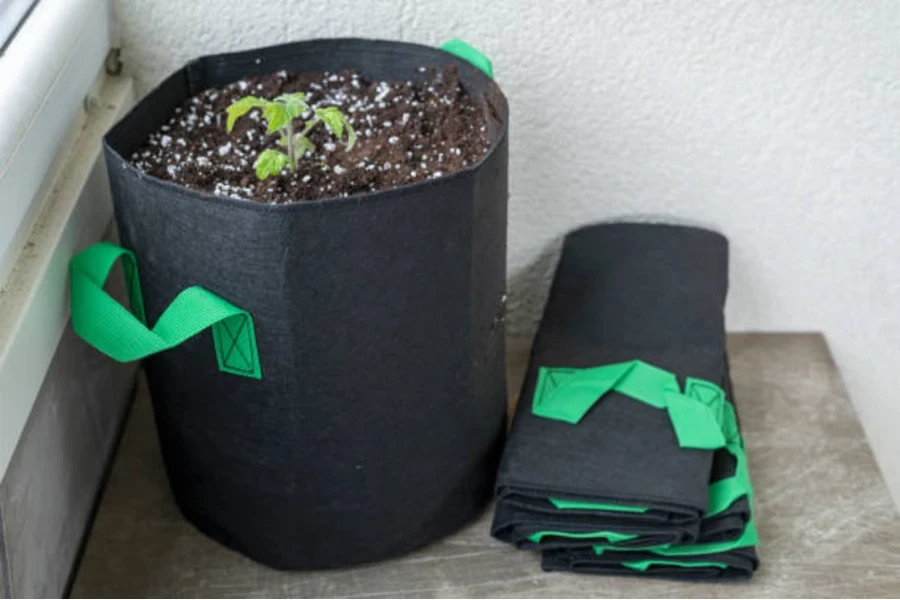
An example of material innovation comes from brands that have introduced UV-stabilized grow bags, designed to endure prolonged exposure to sunlight without breaking down. This feature significantly enhances the lifespan of grow bags, especially in outdoor and greenhouse settings, where solar radiation is a constant factor.
Environmental Considerations: The environmental impact of grow bags pivots largely on the materials used in their production. Eco-friendly options, such as grow bags made from recycled plastics or natural fibers like jute and hemp, have gained traction. These materials contribute to a lower environmental footprint by repurposing waste and reducing reliance on virgin plastics.
Recycled plastic grow bags, for example, transform post-consumer plastic waste into valuable agricultural tools, thereby diverting waste from landfills and reducing the demand for new plastic production. On the other hand, natural fiber grow bags offer a biodegradable alternative that, after its useful life, can decompose without leaving harmful residues in the environment.
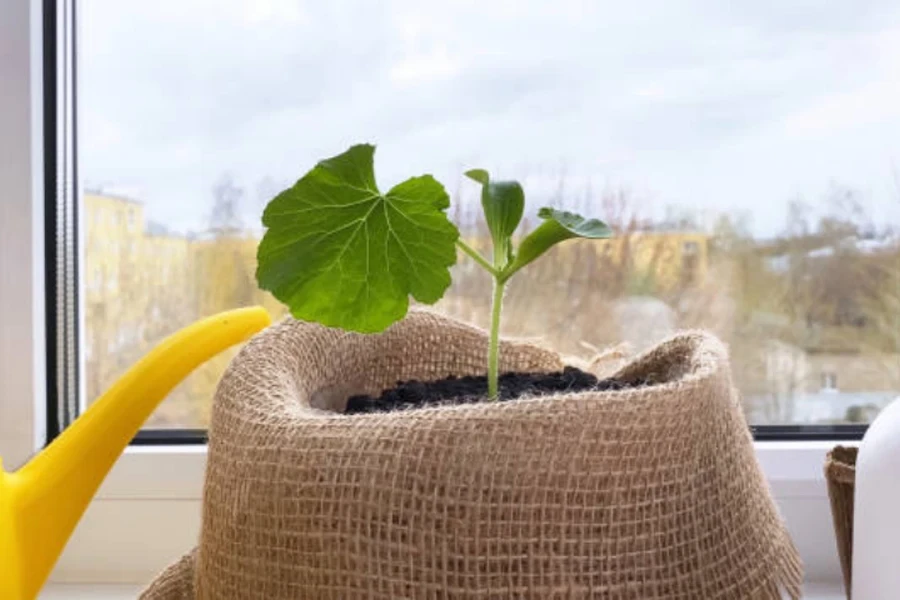
The push towards sustainability has also seen the introduction of compostable grow bags, which, after serving their purpose, can be added to compost piles to break down and enrich the soil. This cycle of use and reuse underscores a shift towards more circular agricultural practices, aligning with global sustainability goals.
The Balance of Durability and Sustainability: Choosing grow bags that balance durability with environmental sustainability requires careful consideration of the materials’ lifecycle, from production to disposal. Premium grow bags that offer extended durability without compromising eco-friendliness represent the ideal choice for modern agricultural practices. Such selections not only ensure the economic viability of farming operations but also contribute to a more sustainable agricultural paradigm.
Design features for enhanced usability
Selecting premium grow bags involves more than just evaluating the material’s environmental footprint or durability; the design features that enhance usability also play a crucial role. These features not only make grow bags more convenient to use but also can significantly impact plant health and the efficiency of garden management.
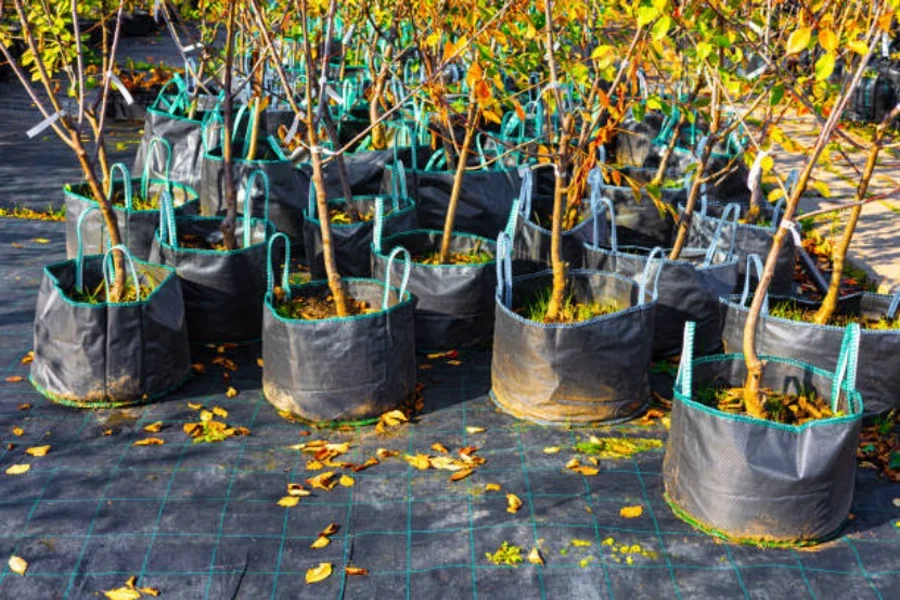
Reinforced Handles: One of the most critical design features for enhanced usability in premium grow bags is the inclusion of reinforced handles. These handles facilitate easy movement and repositioning of the bags, a necessary task for optimizing sunlight exposure and accommodating changing garden layouts. For example, handles made from the same high-density fabric as the bag body, but with additional stitching or riveting, can support the weight of soil, water, and the plant without tearing. This design consideration is particularly important for larger grow bags, where the weight can exceed expectations as plants mature.
Advanced Drainage Systems: Proper drainage is essential for preventing root rot and ensuring optimal soil moisture levels. Premium grow bags often feature advanced drainage systems that go beyond simple holes at the bottom. Some designs include elevated platforms within the bag or use a double-layer fabric that allows water to exit while keeping the soil in place. These systems help manage water retention more effectively, contributing to healthier plant growth by preventing both overwatering and underwatering.
Structural Integrity: Maintaining structural integrity is another crucial design aspect. Some premium grow bags incorporate internal support structures or use sturdier, more rigid materials at the base to keep the bag upright and prevent it from collapsing under the weight of the soil. This feature is particularly beneficial for tall plants that require stability to grow properly. Additionally, structural integrity ensures that the grow bags maintain their shape over time, making them easier to fill, replant, and store when not in use.
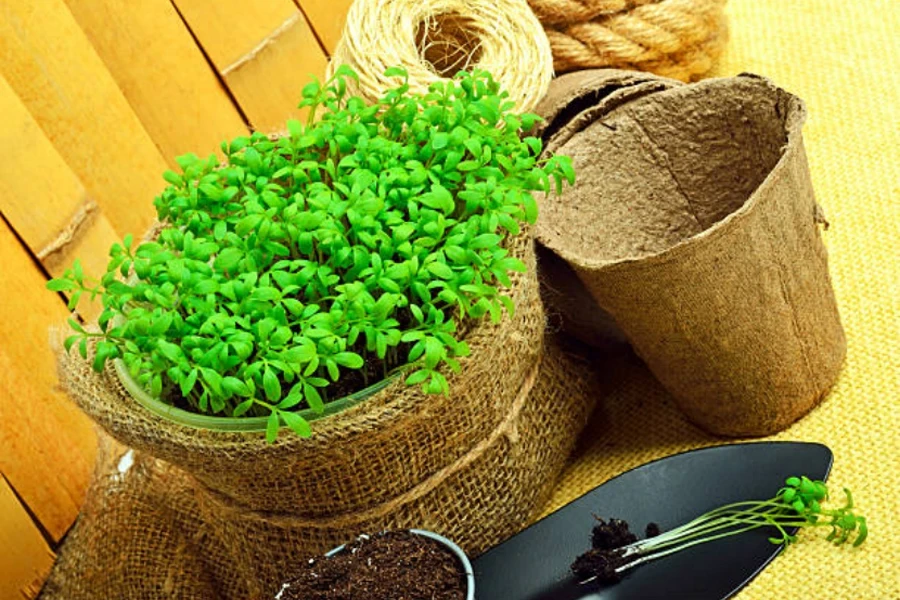
Accessibility Features: For certain types of plants, especially root vegetables like potatoes and carrots, grow bags with accessibility features such as side openings can significantly enhance usability. These openings allow gardeners to harvest produce without disturbing the plant or having to empty the entire bag. This design innovation not only simplifies the harvesting process but also encourages continuous growth by minimizing plant stress.
Versatility in Size and Shape: Finally, the versatility offered by various sizes and shapes of grow bags addresses the diverse needs of different plant types and garden spaces. From tall, narrow bags ideal for deep-rooting plants to wide, shallow designs perfect for leafy greens, the availability of different dimensions ensures that gardeners can select the optimal environment for each plant’s specific growth pattern.
Optimal conditions for plant types
The selection of premium grow bags is a nuanced process that involves considering the specific requirements of different plant species. Each plant has unique needs regarding air, moisture, and space, which are critical to its growth and yield. Understanding these needs and how they translate into the choice of grow bags can significantly impact gardening success.
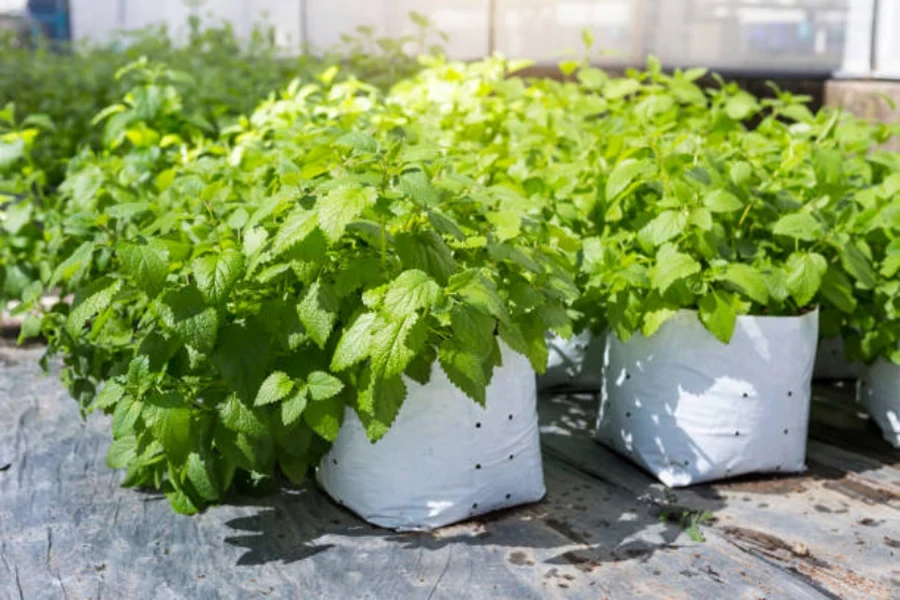
Airflow Requirements: Different plants have varying needs for air at their roots. A plant like an orchid, known for its need for high airflow around its roots, would thrive in a grow bag made from highly breathable fabric that allows for significant air penetration. In contrast, plants that are less dependent on high root oxygen levels might not require such an extensively breathable container. For example, leafy greens and herbs can perform well in slightly less permeable bags, which still offer adequate drainage and aeration without drying out too quickly.
Moisture Management: Water management is another critical factor influenced by the choice of grow bag. Some plants, such as watermelons or cucumbers, have high water needs and benefit from grow bags that retain moisture longer. On the other hand, succulents and some root vegetables prefer drier conditions, making them ideal candidates for grow bags with superior drainage capabilities to prevent water from accumulating around the roots. Premium grow bags often incorporate design features such as double-layered fabric or integrated drainage systems to cater to these diverse moisture requirements.
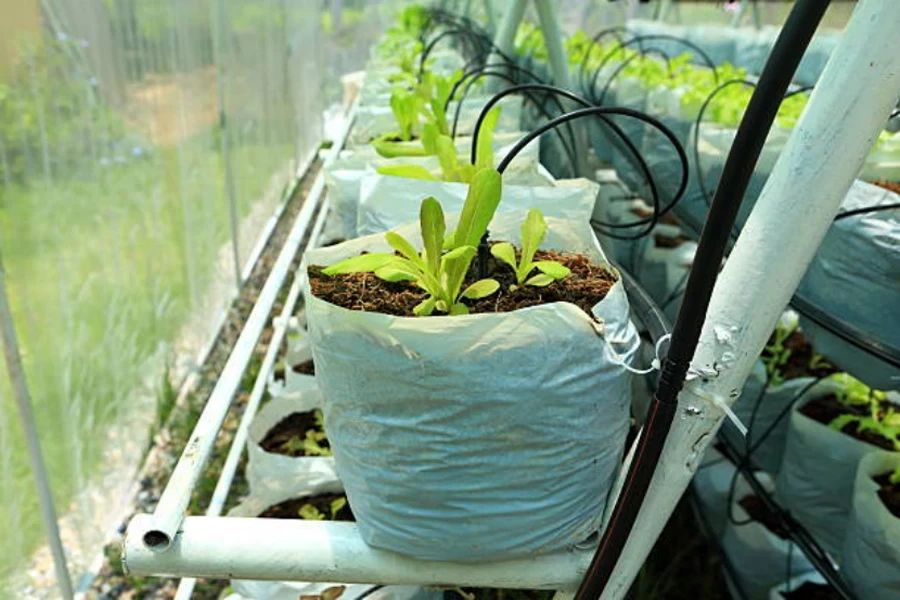
Space for Root Development: The space provided by a grow bag is crucial for root development, directly affecting plant health and yield. Deep-rooted plants, such as tomatoes and peppers, require tall grow bags that allow roots to extend downward without restriction. Conversely, shallow-rooted plants like lettuce and spinach are well-suited to shorter bags, where the root systems can spread out without needing excessive vertical space. Selecting a grow bag with the appropriate depth and width ensures that plants can establish strong, healthy root systems.
Specific Plant to Look: For instance, a premium grow bag for growing potatoes would feature not only the depth to accommodate the plant’s extensive root system but also a side access panel for easy harvesting without disturbing the plant. Similarly, a grow bag designed for strawberries might incorporate vertical planting pockets to maximize space and facilitate fruit picking.
Understanding the optimal conditions required by various plant types enables gardeners to select grow bags that create the ideal environment for each plant’s successful growth. By matching the grow bag’s features with the plant’s needs for air, moisture, and space, gardeners can optimize their gardens for both productivity and sustainability.
Spotlight on 2024’s leading grow bag models
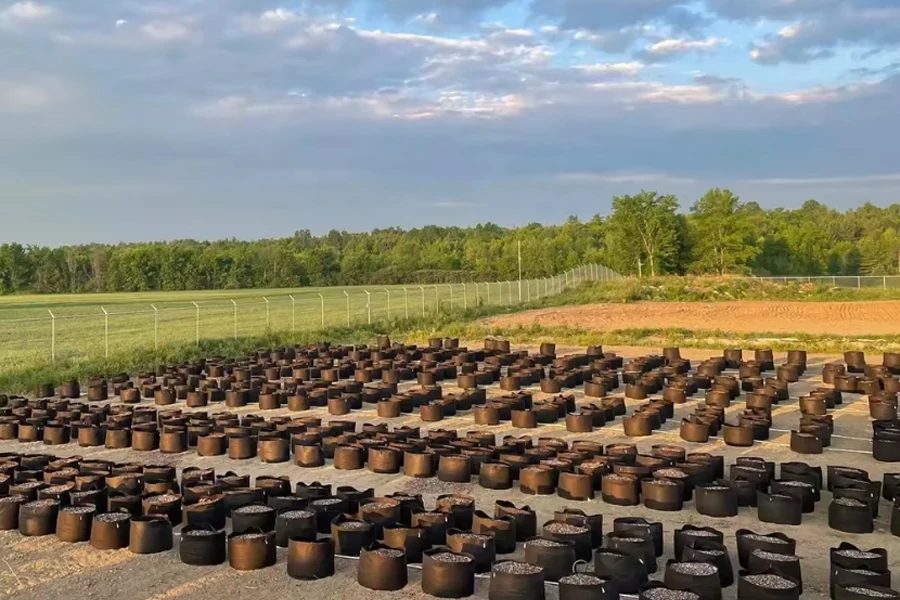
The grow bag market is witnessing an exciting phase of innovation and sustainability as it marches into 2024. The emphasis on eco-friendliness, coupled with technological advancements, is redefining what gardeners expect from their cultivation containers. Here’s a look at the leading grow bag models that are making waves for their sustainable materials, smart features, and versatility.
Eco-friendly innovators
Sustainability is at the forefront of the agricultural industry, with many manufacturers pivoting towards materials that leave a minimal environmental footprint. Eco-friendly grow bags are now being produced using recycled plastics and natural fibers, reducing waste and conserving resources. One standout example includes grow bags crafted from recycled water bottles or textiles, transforming waste into a valuable gardening resource. These models not only support plant health but also align with global efforts to promote sustainable practices in agriculture. The shift towards biodegradable and compostable materials further exemplifies the industry’s commitment to environmental stewardship, offering gardeners options that decompose naturally at the end of their lifecycle, enriching the soil for future planting endeavors.
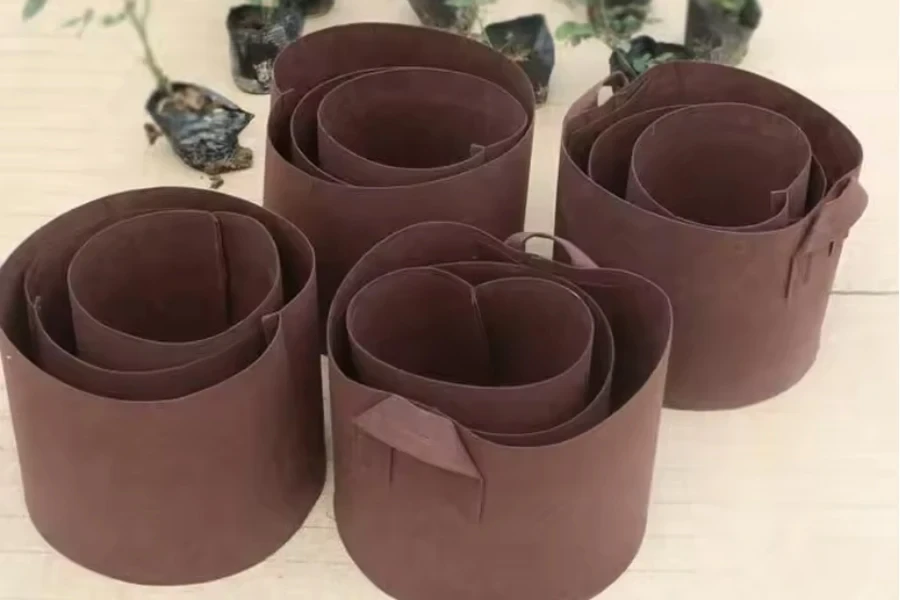
Garden4Ever 5-Pack Grow Bags: These bags stand out for their robust construction and environmental friendliness, offering a sustainable option for gardeners committed to reducing plastic use in their gardening practices. These grow bags are designed with a thick, non-woven fabric that not only supports the plants’ weight but also promotes better air pruning of the roots, leading to healthier and more vigorous growth. The inclusion of handles reinforces the bags’ portability, simplifying tasks such as rotating plants for even sunlight exposure or moving them indoors during unfavorable weather conditions. Available in multiple sizes, these bags are suitable for a wide array of gardening endeavors, from flowering plants to vegetable cultivation, providing gardeners with the flexibility to tailor their garden to their specific interests and space constraints.
Root Pouch Grow Bag: The Root Pouch Grow Bag emerges as a standout choice for gardeners who prioritize environmental sustainability alongside plant health. Crafted from recycled plastic bottles, this grow bag not only offers an eco-friendly gardening solution but also enhances plant growth through its innovative design. The non-degradable fabric encourages air pruning of the roots, leading to a denser root system and, consequently, more robust plant growth compared to traditional plastic pots. This bag’s breathability ensures optimal air circulation and moisture management, significantly reducing the risk of root rot. Suitable for year-round use, its insulating properties protect against temperature extremes, making it a versatile choice for indoor and outdoor gardening. The Root Pouch’s durability and washability promise repeated use across seasons, offering long-term value despite its higher initial cost.
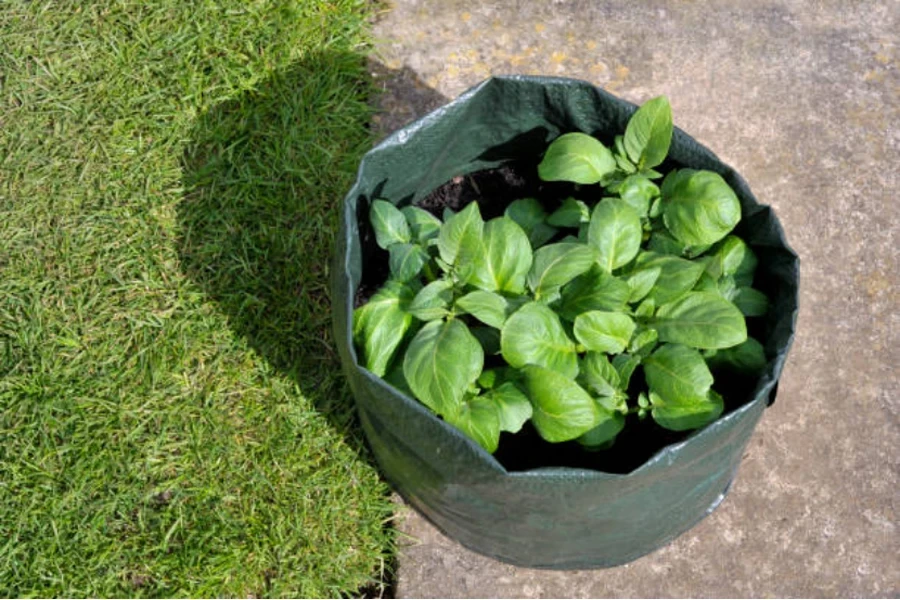
Delxo 5 Pack 7 Gallon Grow Bags: The Delxo 5 Pack 7 Gallon Grow Bags offer a perfect blend of functionality and convenience for gardeners looking to maximize their space, particularly on balconies or in small gardens. Made from a durable 300g nonwoven fabric, these bags provide a breathable environment that promotes healthy root growth and efficient water drainage, minimizing the risks of overwatering and diseases. Their reinforced design ensures they stand upright for easy filling and are equipped with sturdy handles for effortless relocation. What sets these bags apart is their capacity and versatility, accommodating a wide range of plants, including flowers, herbs, and even root vegetables. Additionally, their foldable design allows for easy storage when not in use, and their washability ensures they can be reused for multiple growing seasons, making them an economical and practical choice for urban gardeners and those with limited outdoor space.
Top picks for diverse gardening needs
Recognizing the diverse needs of gardeners, the market boasts a range of grow bag models designed for specific types of plants and gardening scenarios. For vegetable growers, deep, sturdy bags ensure that root crops like carrots and potatoes have ample space to develop. Lightweight and breathable fabric bags are perfect for herbs and leafy greens, promoting air circulation and healthy root growth. Ornamental plants, on the other hand, benefit from grow bags that enhance aesthetic appeal while providing the necessary support for growth. Each category sees leaders that offer something unique, whether it’s enhanced durability, moisture control, or eco-friendly materials, catering to the varied needs of gardeners and ensuring that there’s a perfect grow bag for every plant type.
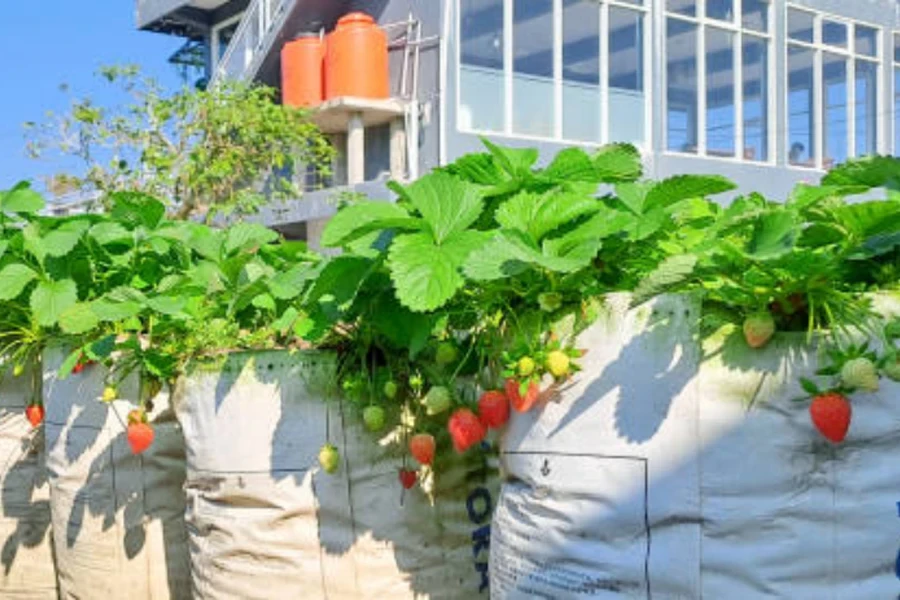
Nicheo’s 3-Piece 6.5 Gallon Grow Bags: Nicheo’s 3-Piece 6.5 Gallon Grow Bags represent the premium pick for those dedicated to cultivating root vegetables like potatoes and beets. These bags are specifically designed to accommodate the unique needs of root crops, featuring breathable sidewalls for air circulation and a Velcro tear hole for easy harvesting. The use of high-quality nonwoven fabric ensures the bags maintain their shape and provide a supportive environment for the plants, enabling gardeners to move the bags without damaging the plants inside. This is particularly beneficial for root vegetables, which require careful handling to prevent disruption to the roots. The inclusion of a harvest window allows gardeners to check on the progress of their crops without disturbing the plant, making these bags an innovative solution for achieving bumper yields of root vegetables.
247Garden 2-Pack 50 Gallon Grow Bags: For tomato enthusiasts, the 247Garden 2-Pack 50 Gallon Grow Bags are the best choice. These large-capacity bags are specifically designed to support the deep root systems of tomato plants, ensuring ample space for growth and development. Constructed from durable non-woven fabric, these bags offer excellent moisture retention and nutrient uptake, critical factors for healthy and productive tomato plants. The significant size of these grow bags makes them more suitable for gardeners planning to cultivate multiple plants or those looking for a substantial yield from their tomato garden. Despite their size, the bags are manageable and can be positioned to maximize sun exposure, catering to the needs of the tomato plants throughout their growth cycle.
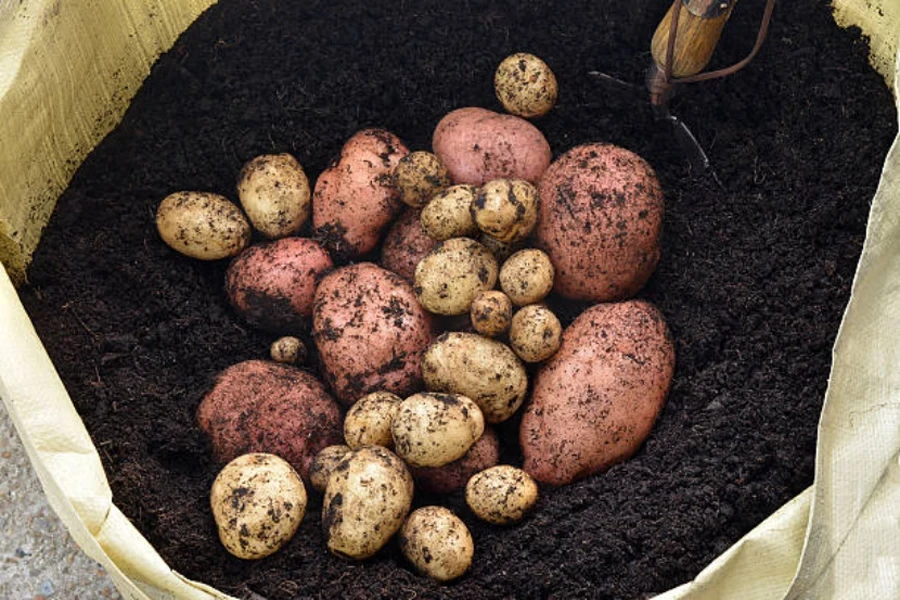
Wraxly Fabric Flower Grow Bags: Adding a pop of color and style to gardens, the Wraxly Fabric Flower Grow Bags are recognized as the best colorful option. These vibrant and aesthetically pleasing grow bags are not just about looks; they are made from breathable, drainable non-woven fabric, ensuring that plants receive the ideal conditions for growth. The sturdy design and secure handles make them easy to move, offering flexibility in garden layout and design. Available in a convenient 7-gallon size, these bags are versatile enough to be used for a variety of plants, from flowers to herbs, adding both functionality and visual appeal to any garden space.
Technologically enhanced variants
The integration of technology into grow bags is revolutionizing how gardeners monitor and manage plant health. Technologically enhanced grow bags equipped with sensors for moisture, nutrient levels, and temperature offer a futuristic approach to gardening. These smart grow bags enable precise monitoring and adjustments, ensuring optimal growing conditions are maintained consistently. For instance, a grow bag with built-in moisture sensors can alert gardeners to watering needs, preventing over or under-watering, and promoting efficient water use. This marriage of technology and traditional gardening tools exemplifies the innovative spirit driving the market forward.
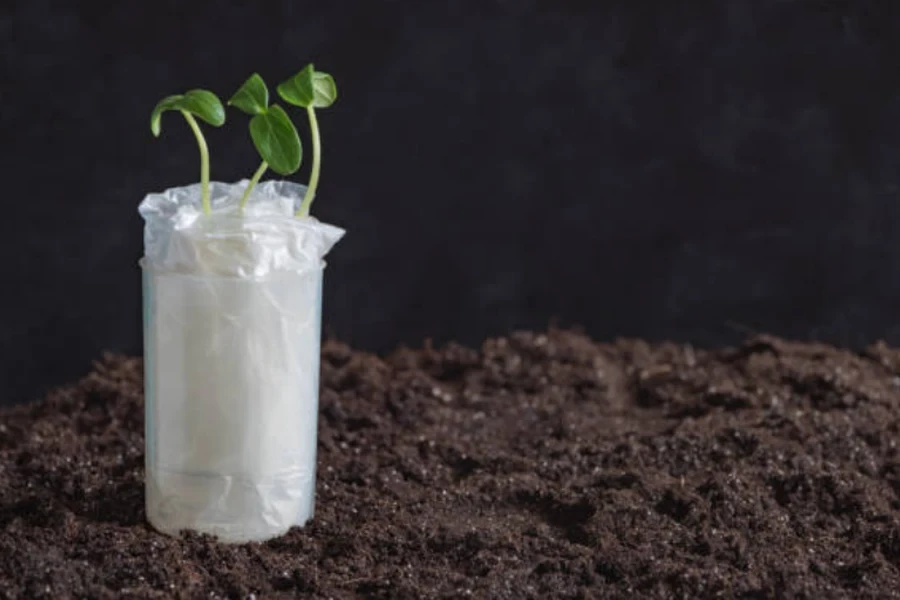
Each of these grow bags offers unique benefits tailored to specific gardening goals, from sustainable and healthy plant growth with the Root Pouch, specialized features for root vegetable cultivation in the Nicheo bags, to the versatile and space-efficient Delxo grow bags. Gardeners can choose based on their environmental values, crop preferences, and spatial constraints, ensuring their gardening projects thrive.
Conclusion
Selecting the right grow bags in 2024 is a multifaceted decision that hinges on balancing functionality, environmental sustainability, and staying attuned to market trends. With advancements in materials that offer both durability and reduced environmental impact, alongside smart design features that cater to specific gardening needs, the choices available reflect a robust response to the demands of modern agriculture. As the industry moves forward, these considerations ensure that professionals can select grow bags that not only support healthy plant growth but also contribute positively to the broader ecosystem and align with evolving market preferences.




